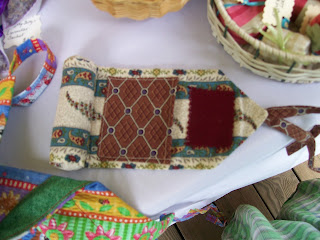Book review time! This installment examines
Civil War Quilts by Pam Weeks and Don Beld. I learned of this book on Barbara Brackman's
Material Culture blog.
First off, I want to say that this is a pretty book. It's full of pictures: original quilts (fronts, backs, inscriptions, close-ups of individual blocks), reproduction quilts, templates, period illustrations, original letters, even photographs of some of the nineteenth century quilt-makers. It's basically everything I want to see in a book on historic quilts.
The book is organized in two distinct parts. Ms. Weeks uses the first half of the book to examine surviving quilts with Civil War provenance: one made by a recuperating soldier, fourteen others by northern women (mostly in groups). She gets into great detail on the patterns and techniques used, and also flushes out the story of the makers--when identified--using census data and local histories. Mr. Beld's half gives techniques for reproducing quilts, including full-sized templates for each block* in the original quilts, and a few bonus ones from the period. Finishing techniques, tips for signing blocks, and a short fabric guide are also included, all extensively illustrated.
In addition to the large number of pictures, I really like the detail that this book goes into: the sizes and number of blocks in each quilt are given; inscriptions are featured (and most are copied into the text); finishing/quilting methods are addressed; the authors even point which signed blocks are in the same handwriting versus different ones. There's a bibliography at the end, and footnotes are used throughout. There's even a table comparing the original quilts, so you can quickly relate location/date/construction method/etc.
The only downsides I see to this book are ones of editing and format. At times, the narrative seems to run between different topics and cycle back in a less-than-ideally-organized way. I also encountered a dozen-odd typos in a casual reading; in a 192-page book, that's not a lot, but it's more than I usually notice. A number of pages near the end were devoted to the "Home of the Brave" project, in which quilters make reproduction ACW quilts for the families of current Armed Forces casualties. While laudable, that portion seemed tangential to the main topic (though this book would be a very useful for someone engaged in that work).
Score: 4-4.5 Stars
Accuracy: High. It's all original quilts.
Difficulty: Most of the reproduction quilt projects are suitable for a beginner (nine patches and other straight-seamed blocks). Period techniques are fairly well explained.
Strongest Impression: Overall, I find this a highly informative book with good, quality research presented in a beautiful and useful way.
*Each patchwork block, that is. There are also a few applique designs in the original quilts, but only one applique template--an eagle--is included.
























